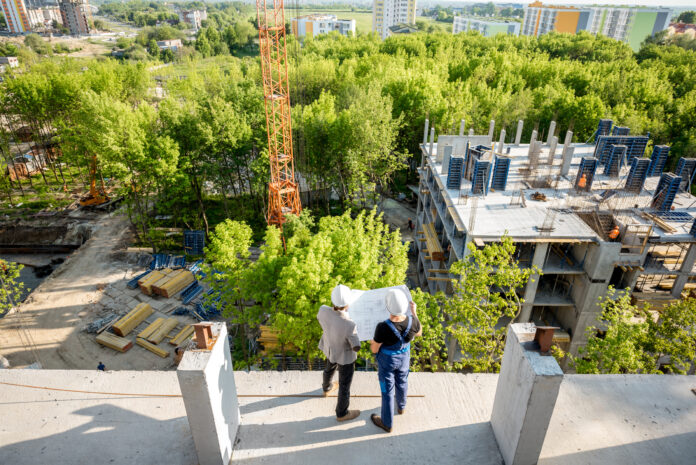
Landscape architect, Colm Kenny, on the intricacies of the tender process and contract negotiation; effective pricing with rising inflation, and how to ensure that all risks are planned for.
The core activities of landscape maintenance continued during the pandemic, but many commercial landscape construction companies were badly hit when restrictions came into place. I suspect many will not recover, and others have chosen to retire or leave the sector. Other companies were able to keep operating – often under the radar – and were able to capitalise on the burgeoning domestic market. Regardless, the sector welcomed the return to full operations in April of last year and is busy trying to catch up with the pent-up demand: challenging, given the labour shortage, supply chain issues, and material cost increases.
The challenges faced by the sector as it gets back to its feet are being felt on the ground, in the office, and certainly reflected in tender prices. The most recent Tender Price Index, published in October of 2021 by The Society of Chartered Surveyors Ireland (SCSI), reveals that national construction tender prices increased by 7% in the first half of 2021, up from 1.3% in the previous six months. From what I see coming across my desk, the increases will be much more significant this year.
While we don’t have the luxury of such data being recorded specific to the landscape industry, we can be confident that landscape contracting, as a sub-sector of the general construction sector, has witnessed prices rising in line with the Tender Price Index. In my role as a quantity surveyor, this has been evident on projects I am currently employed on, with cost plans and pre-start estimates wide of the mark. This results in projects being over budget before they even begin.
The factors causing price increases don’t need further explanation, but it’s important for contractors to fully understand the risks they pose on every project. I would be fearful, when legal contracts are binding between a contractor and a client, that the contractual risks of inflation are not accurately considered. From a legal perspective, as prices continue to rise, parties in the process of negotiating contracts are becoming more focused on who should bear the risk of cost increases. Early communication is important to ensure all parties are aware of the consequences.
Where a contractor is directly employed by the client, the project is commonly procured under the Royal Institute of Architects Ireland standard form contract. Clause 36 places the risk of price inflation for materials on the employer (however, for larger projects this position is often reversed, with the contractor shouldering the risk). I have often seen this Clause struck out, and an opportunity for the contractor to set a lump sum on the Form of Tender to cover inflation. More often than not this is left blank and, if costs rise, the contractor must shoulder the burden and absorb it into the overall tender price.
Landscape contractors directly employed by a contractor are likely to be tied into a subcontractor agreement, written heavily in favour of the main contractor, whether they sign a formal written agreement or not. The terms can be implied, especially if it’s a long-standing relationship and the parties have worked together in the past. The risk on these projects requires intensive management and smarter pricing strategies.
With the risk of inflation across a project’s duration as the backdrop, to protect profits from the erosion of inflation there are several steps contractors should undertake, or at least evaluate, when sitting down to estimate a potential project.
Firstly, ensure you have a full understanding of when the project will commence and how long it will be on-site. On city centre projects, as the density of buildings increases, the volume of landscape works decreases. Here I am finding that the completion of landscape work takes longer as the sites are tighter and only small areas become available for landscaping. Mobilisation and demobilisation costs money. The more times you move machinery on and off-site, the more costs you accumulate. It is prudent to request any phasing drawings so that mobilisation and demobilisation costs can be built into your rates. In addition, while you might be appointed at the commencement date of the project, it might be months before you have any work to do, meaning it might be next season when you commence planting. Material costs may have risen by this time. The construction programme should be made available to you. This will give you a clear picture of anticipated timescales that can be taken into account when estimating and forecasting future costs.
Unless you have the luxury of a large storage yard and the cash flow to purchase and take delivery of all required materials upfront, the option of having the materials sitting ready to go is a non-runner. Therefore, when shopping around for material quotes, it is important to provide suppliers with as much information as possible (timescales, etc.) and to negotiate a binding cost for the materials. This may be easier with plants and trees as it almost becomes a contract grower agreement for the nursery. It will be more difficult for paving providers who, like the landscape contractor, suffer cash flow limitations and may be unwilling to shoulder the burden.
On smaller garden projects, from the time you engage with the homeowner client, submit a quotation, and get the nod to commence work, several months can slip by. In this time costs can rise, eating into your profit margins. An example of this is fuel costs, which are currently spiralling towards €1.80 per litre. This cost might be absorbed into the overall job, but depending on the scale and location of the project, it could see the contractor undertaking works for less than cost.
In the short-term, costs are going to continue to rise. Contractors need to assess what increasing costs will mean in terms of cash flow and profit margins. With most items due to be paid upfront, contractors already living close to overdraft limits will be hesitant and fearful to tender for larger projects. The time between having to pay for the materials and getting paid from the client can be too long. This will potentially limit business growth and expansion for smaller contractors.
For fearless contractors pricing on projects that may not require their services for a few months, a record of how tender rates were calculated is important. When the client calls to offer the job, you need to remind your suppliers of their rates. It would be prudent to add a percentage to cover general inflation on items that are not measured with a BOQ. Fuel, wage cost increases, and general costs need to be factored in, even at the expense of losing the contract. ‘Quality over quantity’ should be the mantra for the season ahead. Projects with more lucrative profit margins should be prioritised. Now more than ever.
Colm’s golden rules for pricing in an inflationary market.
- Categorise items into timescales to identify potential inflationary impacts
- Speak to suppliers and establish potential price changes over time
- Reflect potential changes in tender rates
- Keep a good record of what suppliers have quoted for
- Identify who will foot the bill for price changes
- Ensure quotations or tenders indicate the basis of rates provided and any potential increases (if possible)

Colm Kenny, MSCSI MRICS MILI, is unique in Ireland as he is both a chartered quantity surveyor and a Landscape Architect. He provides cost consultancy services to landscape industry professionals, technical advisors, contractors and facility management companies. He can be contacted on 086 874 4300 or by email info@landscapeqs.ie |





